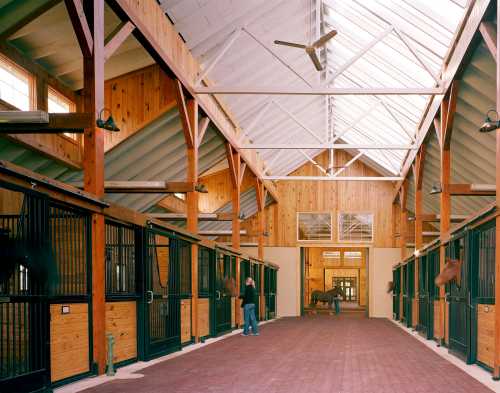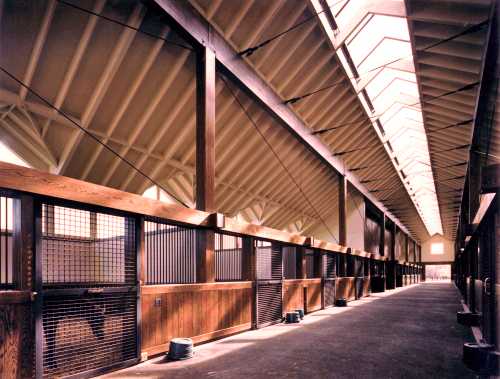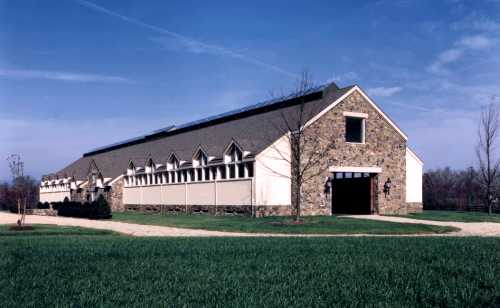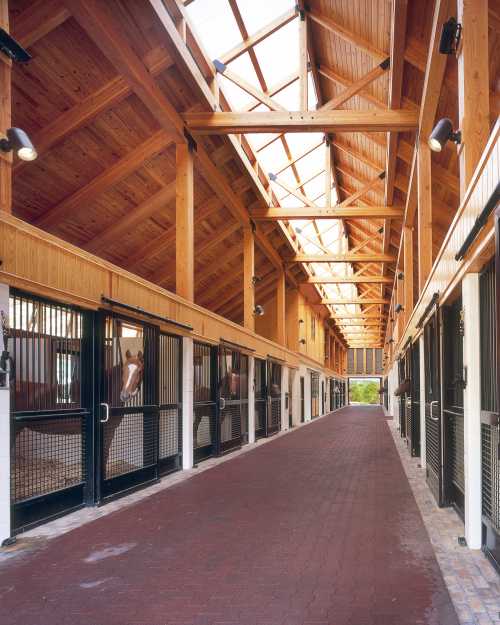|
By Jerry Tardif
Several years ago I wrote an article for Practical Horseman magazine (Feb. 2009) entitled Better Barn Lighting.
The piece discusses lighting options, electrical power usage, and how to save money on lighting costs as well as brightening and making a barn more cheerful.
In the process, I found and took advantage of the insights of an architect that designs beautiful, upscale barns and included some of his suggestions in the article.
The architect's name is John Blackburn and he recently published a book entitled "Healthy Stables by Design".
I've just read the book and am very favorably impressed!
The design goal of the barns in the book is to provide a healthier environment for horses as well as excellent lighting and a peaceful, comfortable place for humans to enjoy being around horses.
Each chapter focuses on a specific barn that Blackburn and his architectural firm designed.
He explores the challenges that his company faced in terms of the needs and desires of the client, various landscape obstructions, local zoning restrictions, and how they resolved problems and achieved the client's goals while meeting all local requirements.
In some cases, Blackburn also designed additional buildings and landscape changes.
There is discussion of how they situated the barn to create vertical airflow patterns that rid each barn of pathogens, dust, and product off-gassing without subjecting the horses to any of it.
This is different than the typical barn wherein air flowing in at one end of the barn picks up dust, chemical gases, (e.g. from cleansers, fly sprays, etc.) or germs from a sick horse and exposes all the other horses in the barn to these airborne particles before it finally blows out the other end of the barn.

|

Photos Courtesy of Maxwell MacKenzie
|
|
River Farm in Virginia On the Potomac Near Washington D.C.
|
The barns highlighted in the book come from a sampling across the U.S. in both cold and warm climates.
There's discussion about roof designs and height, using skylights to provide lots of natural, full-color and free lighting, providing ample space for horses, vehicles, and people to go about their various responsibilities as well as hay storage and access.
Many of the barns include additional outside stall doors so that the horses have easy access to their paddocks.
This approach also provides horses with a way out in case of fire without requiring human intervention.

|

Photos Courtesy of Harlan Hambright
|
|
Heronwood Farm in Upperville, Virginia.
|
One thing that jumped out at me as I read the book was the extent to how external factors could affect the horses inside.
For example, Heronwood is a breeding farm and Blackburn goes on to describe that a broodmare's cycle is often disturbed by continuous artificial lighting or leaving lights on out-of-sync with nature.
Conversely, broodmares living with natural lighting are more likely to carry their foals to term.
While this obviously makes sense, few barns I've seen make much use of natural light.
Rather, they use electric lighting and the time of day the barn is lit is usually determined by the convenience of humans rather than the natural diurnal cycle of benefit to the broodmares.
Using natural lighting addresses those natural cycles as well as significantly reducing the money spent on electricity for lighting during the day.

Photos Courtesy of Tre Dunham
|
|
Oakhaven Farm Near Austin, Texas.
|
For the Oakhaven barn in its hot Texas environment, a design decision was made to place sky lighting only on the North side so as to avail the client and horses of natural light while reducing solar gain and its associated heat buildup in the barn.
Therefore, designing these barns was not just a simple matter of building the same kind of structure at all locations (which is something I've seen quite a bit of around the country).
Rather, each locale required that its own design requirements be met to assure a barn that worked well in its environment, both for the horses and the owners.
I found some of the requirements mentioned to present significant problems, such as one owner's desire to have a low-profile barn.
This makes it much harder to establish and maintain a sufficient vertical airflow for ventilation.
At other sites, local zoning requirements or limitations seemed arduous enough that they could derail the project.
Yet, I very much enjoyed the creativity Blackburn's firm used to resolve them and I appreciated his sharing them in the book for the reader's consideration and enlightenment.
This is a beautiful book, the kind one keeps as a reference, is over 180 pages, and reviews fourteen of the barns Blackburn has designed.
It is adorned with many large photographs of the barns being described (I've included several photo samples in this review) and is printed in beautiful four-color process on high-quality semi-gloss paper.
Plot layouts are also included so the reader can "get the feeling" of the barn and property.
This is the kind of book with which one loves to sit down on a quiet afternoon to enjoy without interruption.
Blackburn is donating all profits from the book to equine charities.
To learn more about the book or to actually get your hands on it, click here.
Besides being an avid trail rider, Jerry Tardif is a technology consultant and a horse and nature photographer in SE Connecticut — see his work at: www.jerrytardif.com.
He is also co-founder and President of QueryHorse.
Back to Article Index
|